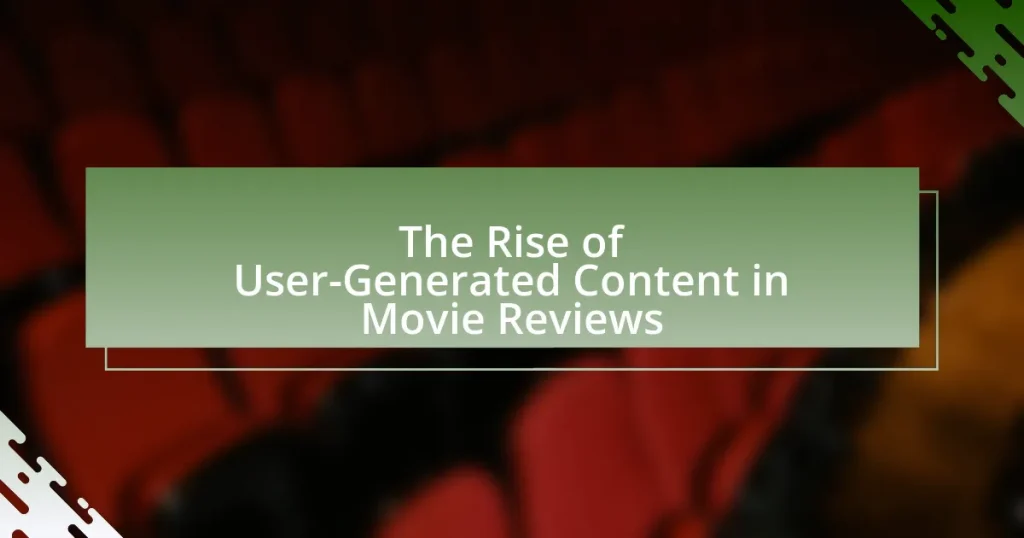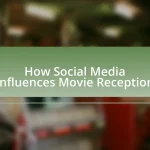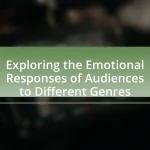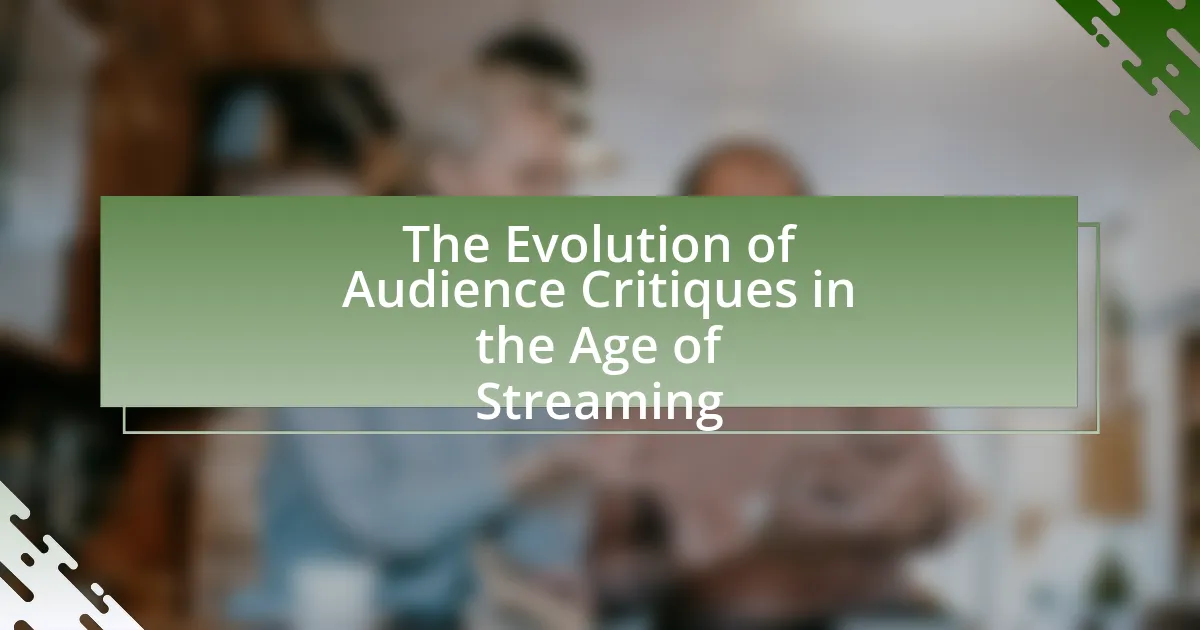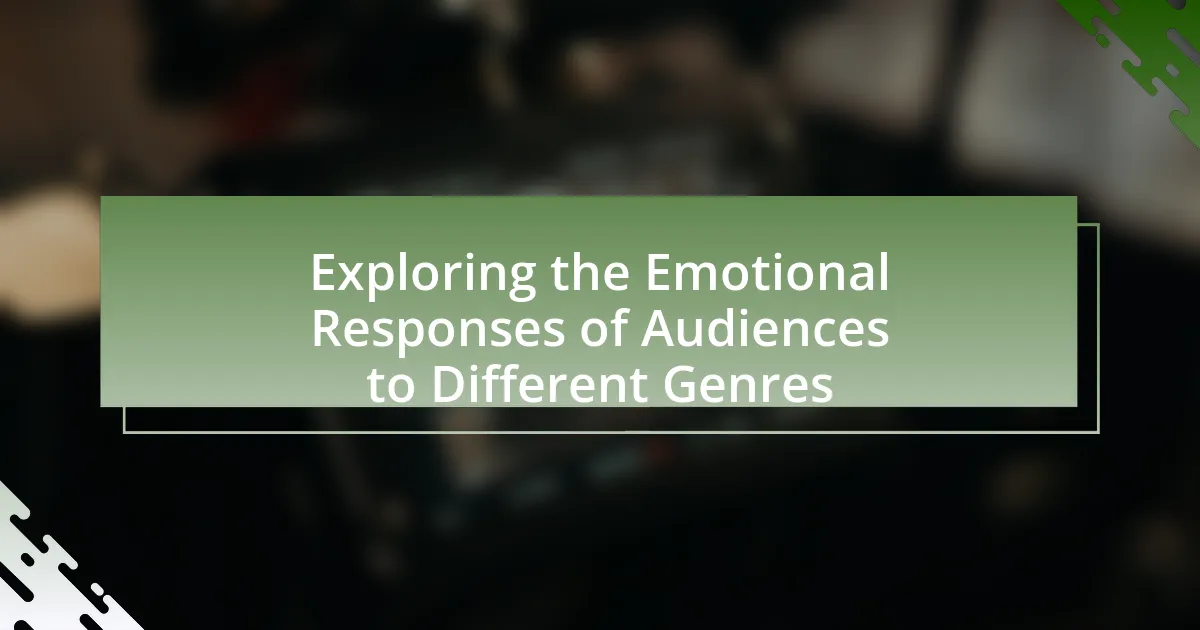User-Generated Content (UGC) in movie reviews refers to reviews and ratings created by everyday viewers rather than professional critics, significantly transforming audience engagement with films. This article explores the evolution of UGC in the film industry, highlighting key milestones, the influence of technology, and the importance of platforms like IMDb and Rotten Tomatoes. It examines how UGC impacts traditional movie criticism, audience engagement, and marketing strategies for filmmakers and studios, while also addressing the challenges and best practices associated with creating and managing user-generated reviews. The implications of UGC for filmmakers, including its potential to shape public perception and box office performance, are also discussed.

What is User-Generated Content in Movie Reviews?
User-Generated Content in movie reviews refers to reviews and ratings created by individuals rather than professional critics or studios. This content is typically shared on platforms like IMDb, Rotten Tomatoes, and social media, allowing everyday viewers to express their opinions and experiences regarding films. The rise of this type of content has transformed how audiences engage with movies, as it provides diverse perspectives and democratizes film criticism, making it accessible to a broader audience.
How has User-Generated Content evolved in the film industry?
User-Generated Content (UGC) in the film industry has evolved significantly from simple audience feedback to a powerful tool influencing film marketing and production. Initially, UGC primarily consisted of basic reviews and ratings on platforms like IMDb and Rotten Tomatoes, where viewers shared their opinions post-viewing. Over time, the rise of social media platforms such as YouTube, Instagram, and TikTok has transformed UGC into a dynamic form of engagement, allowing fans to create trailers, parodies, and commentary that can reach millions.
This evolution is evidenced by the increasing reliance of studios on audience-generated content for promotional campaigns; for instance, films like “Deadpool” and “The Blair Witch Project” utilized fan-created content to build hype and community engagement. Additionally, the integration of UGC into marketing strategies has been shown to enhance viewer trust and interest, as 79% of consumers say user-generated content highly impacts their purchasing decisions, according to a study by Nielsen. Thus, UGC has transitioned from mere commentary to a vital component of the film industry’s ecosystem, shaping how films are marketed and perceived.
What are the key milestones in the rise of User-Generated Content?
The key milestones in the rise of User-Generated Content (UGC) include the launch of platforms like YouTube in 2005, which enabled users to upload and share videos, significantly increasing content creation. In 2006, the term “User-Generated Content” was popularized by the media, highlighting the shift towards consumer-driven content. The introduction of social media platforms such as Facebook and Twitter in the late 2000s further accelerated UGC by allowing users to share opinions and reviews widely. By 2010, sites like Rotten Tomatoes and IMDb began integrating user reviews, establishing a formal space for audience feedback on movies. The proliferation of smartphones and mobile apps in the 2010s made it easier for users to create and share content instantly, solidifying UGC’s role in shaping public perception of films. These milestones collectively demonstrate the evolution and impact of user-generated content in the film industry.
How has technology influenced the growth of User-Generated Content?
Technology has significantly influenced the growth of User-Generated Content (UGC) by providing accessible platforms and tools for individuals to create and share their opinions. The advent of social media, blogs, and review sites has democratized content creation, allowing users to publish movie reviews easily. For instance, platforms like IMDb and Rotten Tomatoes enable users to contribute reviews and ratings, fostering a community-driven approach to film critique. According to a 2021 report by Statista, over 50% of consumers trust user-generated reviews as much as personal recommendations, highlighting the impact of technology on audience engagement and content credibility. This shift has transformed how audiences interact with films, making UGC a vital component of the movie review landscape.
Why is User-Generated Content important for movie reviews?
User-Generated Content (UGC) is important for movie reviews because it provides diverse perspectives that enhance the overall understanding of a film. This content reflects the opinions of a broader audience, allowing potential viewers to gauge public sentiment beyond professional critics. Research indicates that 79% of consumers trust online reviews as much as personal recommendations, highlighting the influence of UGC on decision-making. Furthermore, platforms like Rotten Tomatoes and IMDb leverage user reviews to create aggregate scores, which significantly impact a film’s box office performance and critical reception.
What impact does User-Generated Content have on audience engagement?
User-Generated Content (UGC) significantly enhances audience engagement by fostering a sense of community and trust among viewers. When audiences contribute their own reviews and opinions, they feel more connected to the content and to each other, which increases their likelihood of interacting with the material. According to a study by the Nielsen Company, 92% of consumers trust peer recommendations over traditional advertising, highlighting the influence of UGC on audience perceptions and engagement levels. This trust translates into higher interaction rates, as audiences are more inclined to share, comment on, and discuss content that includes their own contributions or those of their peers.
How does User-Generated Content affect traditional movie criticism?
User-Generated Content (UGC) significantly alters traditional movie criticism by democratizing the review process and providing diverse perspectives. Traditional critics often rely on established industry standards and personal expertise, while UGC allows everyday viewers to share their opinions, leading to a broader range of insights and experiences. This shift is evidenced by platforms like Rotten Tomatoes and IMDb, where user ratings and reviews can influence a film’s reception and box office performance. Studies indicate that audiences increasingly trust peer reviews over professional critiques, with a 2019 survey showing that 79% of consumers trust online reviews as much as personal recommendations. Consequently, traditional movie critics must adapt to this evolving landscape by considering audience sentiment and integrating UGC into their analyses.

What platforms facilitate User-Generated Content in Movie Reviews?
Platforms that facilitate User-Generated Content in Movie Reviews include IMDb, Rotten Tomatoes, Letterboxd, and social media platforms like Facebook and Twitter. IMDb allows users to post reviews and ratings, contributing to a comprehensive database of film opinions. Rotten Tomatoes aggregates user reviews alongside critic scores, providing a dual perspective on films. Letterboxd is specifically designed for film enthusiasts to log, review, and discuss movies, fostering a community around film critique. Social media platforms enable users to share their thoughts and reviews widely, influencing public perception and engagement with films. These platforms collectively enhance the visibility and impact of user-generated content in the realm of movie reviews.
Which social media platforms are most popular for sharing movie reviews?
The most popular social media platforms for sharing movie reviews are Twitter, Facebook, Instagram, and TikTok. Twitter is widely used for its real-time updates and concise reviews, while Facebook allows for longer discussions and community engagement. Instagram’s visual focus enables users to share aesthetically pleasing content related to films, and TikTok has gained traction for its short, engaging video reviews. According to a 2022 survey by the Pew Research Center, 69% of adults in the U.S. use Facebook, and 23% use Twitter, highlighting their significance in the movie review landscape.
How do different platforms cater to User-Generated Content?
Different platforms cater to User-Generated Content (UGC) by providing tools and features that facilitate content creation, sharing, and engagement. For instance, social media platforms like Facebook and Instagram allow users to post reviews, photos, and videos, enabling interaction through likes and comments, which enhances visibility and community engagement. Review sites such as Rotten Tomatoes and IMDb specifically focus on movie reviews, offering structured formats for users to submit their ratings and opinions, thus creating a repository of diverse perspectives. Additionally, platforms like YouTube empower users to create video reviews, leveraging algorithms that promote popular content, thereby increasing user participation. These strategies collectively foster an environment where user-generated content thrives, contributing to the overall discourse in movie reviews.
What features enhance User-Generated Content on these platforms?
User-generated content on platforms is enhanced by features such as user ratings, comment sections, and social sharing options. User ratings allow individuals to express their opinions quantitatively, making it easier for others to gauge the overall sentiment of the content. Comment sections facilitate discussions and provide a space for users to elaborate on their thoughts, fostering community engagement. Social sharing options enable users to disseminate their reviews across various networks, increasing visibility and encouraging more contributions. These features collectively promote interaction and enhance the richness of user-generated content, as evidenced by platforms like IMDb and Rotten Tomatoes, where user engagement significantly influences content perception and popularity.
What role do review aggregators play in User-Generated Content?
Review aggregators serve as crucial platforms for consolidating and displaying user-generated content, specifically movie reviews, by collecting and summarizing opinions from various sources. These aggregators enhance the visibility of individual user reviews, allowing potential viewers to access a broader spectrum of perspectives in one location. For instance, platforms like Rotten Tomatoes and Metacritic compile ratings and reviews from both critics and users, providing an overall score that reflects public sentiment. This aggregation not only aids consumers in making informed decisions but also amplifies the influence of user-generated content in shaping the perception of films, as evidenced by the significant impact of audience scores on box office performance and critical reception.
How do aggregators influence public perception of movies?
Aggregators influence public perception of movies by consolidating user-generated reviews and ratings, which shape audience expectations and viewing decisions. These platforms, such as Rotten Tomatoes and Metacritic, provide a quantitative score that summarizes critical and audience feedback, making it easier for potential viewers to gauge a film’s reception. Research indicates that high scores on these aggregators can significantly increase a movie’s box office performance, as seen in a study by the University of California, which found that a one-point increase in Rotten Tomatoes scores correlates with a 4% increase in ticket sales. Consequently, aggregators play a crucial role in shaping the narrative around a film, often leading to a bandwagon effect where positive ratings attract more viewers, while negative scores can deter potential audiences.
What are the challenges faced by review aggregators in curating User-Generated Content?
Review aggregators face several challenges in curating User-Generated Content, primarily including the authenticity of reviews, the volume of submissions, and the management of biased or fake reviews. Authenticity is crucial, as aggregators must verify that reviews are genuine and not fabricated, which can be difficult given the anonymity of many online platforms. The sheer volume of user submissions can overwhelm aggregators, making it challenging to filter and assess the quality of content effectively. Additionally, biased or fake reviews can distort the overall perception of a movie, leading to misleading ratings; for instance, a study by the University of California found that up to 30% of online reviews may be fake, highlighting the need for robust verification processes. These challenges necessitate sophisticated algorithms and human oversight to ensure the integrity and reliability of the aggregated content.

What are the implications of User-Generated Content for filmmakers and studios?
User-Generated Content (UGC) significantly impacts filmmakers and studios by altering audience engagement and marketing strategies. Filmmakers and studios must adapt to the reality that UGC can shape public perception and influence box office performance, as seen in the rise of platforms like Rotten Tomatoes, where user reviews can affect a film’s rating and visibility. Additionally, UGC provides filmmakers with valuable feedback and insights into audience preferences, enabling them to tailor future projects more effectively. The integration of UGC into marketing campaigns can enhance authenticity and relatability, as consumers often trust peer reviews over traditional advertising. This shift necessitates that filmmakers and studios develop strategies to leverage UGC while managing potential negative feedback, which can spread rapidly through social media channels.
How does User-Generated Content shape marketing strategies for films?
User-Generated Content (UGC) significantly shapes marketing strategies for films by enhancing audience engagement and building trust. UGC, such as reviews, fan art, and social media posts, allows filmmakers to tap into authentic consumer voices, which can influence potential viewers’ perceptions and decisions. For instance, a study by Nielsen found that 92% of consumers trust recommendations from individuals over brands, highlighting the effectiveness of UGC in swaying public opinion. Additionally, films that actively encourage and showcase UGC often see increased social media buzz and organic reach, leading to higher ticket sales and broader audience engagement.
What are the benefits of leveraging User-Generated Content in promotional campaigns?
Leveraging User-Generated Content (UGC) in promotional campaigns enhances authenticity and engagement, leading to increased consumer trust and brand loyalty. UGC serves as social proof, as 79% of people say user-generated content highly impacts their purchasing decisions, according to a study by Nielsen. Additionally, UGC can reduce marketing costs, as brands can utilize content created by their customers instead of producing all promotional material in-house. This approach not only fosters community but also encourages customers to share their experiences, amplifying brand reach and visibility.
How can filmmakers respond to User-Generated Content effectively?
Filmmakers can respond to User-Generated Content (UGC) effectively by actively engaging with audiences through social media platforms and incorporating feedback into their marketing strategies. Engaging with UGC allows filmmakers to build a community around their films, fostering loyalty and encouraging word-of-mouth promotion. For instance, a study by the Pew Research Center found that 72% of internet users engage with content shared by others, highlighting the importance of interaction. By acknowledging and sharing user reviews or fan-created content, filmmakers can enhance their visibility and create a more personalized connection with their audience, ultimately leading to increased interest and viewership.
What challenges do filmmakers face with User-Generated Content?
Filmmakers face significant challenges with User-Generated Content (UGC), primarily concerning quality control, copyright issues, and audience perception. The quality of UGC can vary widely, leading to potential misrepresentation of a film’s value or message, which can affect box office performance. Additionally, copyright concerns arise when filmmakers must navigate the legal implications of using content created by fans or viewers, as unauthorized use can lead to legal disputes. Furthermore, filmmakers must contend with audience perception, as negative UGC can influence public opinion and deter potential viewers, impacting a film’s success. These challenges highlight the complexities filmmakers encounter in integrating UGC into their marketing and distribution strategies.
How can negative User-Generated Content impact a film’s success?
Negative User-Generated Content can significantly hinder a film’s success by influencing public perception and reducing audience turnout. Research indicates that 79% of consumers trust online reviews as much as personal recommendations, meaning negative reviews can deter potential viewers. For example, films like “Cats” (2019) faced substantial backlash on social media, leading to a disappointing box office performance, grossing only $73 million against a $95 million budget. This illustrates how detrimental negative user feedback can be, as it shapes audience expectations and can lead to decreased interest and revenue.
What strategies can filmmakers use to mitigate risks associated with User-Generated Content?
Filmmakers can mitigate risks associated with User-Generated Content (UGC) by implementing clear content guidelines and establishing robust moderation processes. By defining acceptable content standards, filmmakers can ensure that UGC aligns with their brand values and legal requirements. For instance, utilizing automated tools and human moderators to review submissions can help filter out inappropriate or harmful content before it reaches the public. Additionally, filmmakers can encourage positive engagement by incentivizing users to create constructive reviews, thereby fostering a community that supports the film’s narrative. Research indicates that 79% of consumers trust online reviews as much as personal recommendations, highlighting the importance of managing UGC effectively to maintain a positive public perception.
What best practices should users follow when creating movie reviews?
Users should follow several best practices when creating movie reviews to ensure clarity and engagement. First, they should provide a clear summary of the movie’s plot without revealing spoilers, as this helps readers understand the context. Additionally, users should express their personal opinions supported by specific examples from the film, such as character development or cinematography, to enhance credibility. Furthermore, maintaining a respectful tone and avoiding excessive negativity fosters a constructive discussion. Lastly, users should proofread their reviews for grammar and coherence, as well-structured writing improves readability and professionalism. These practices contribute to the overall quality and impact of user-generated content in movie reviews.
